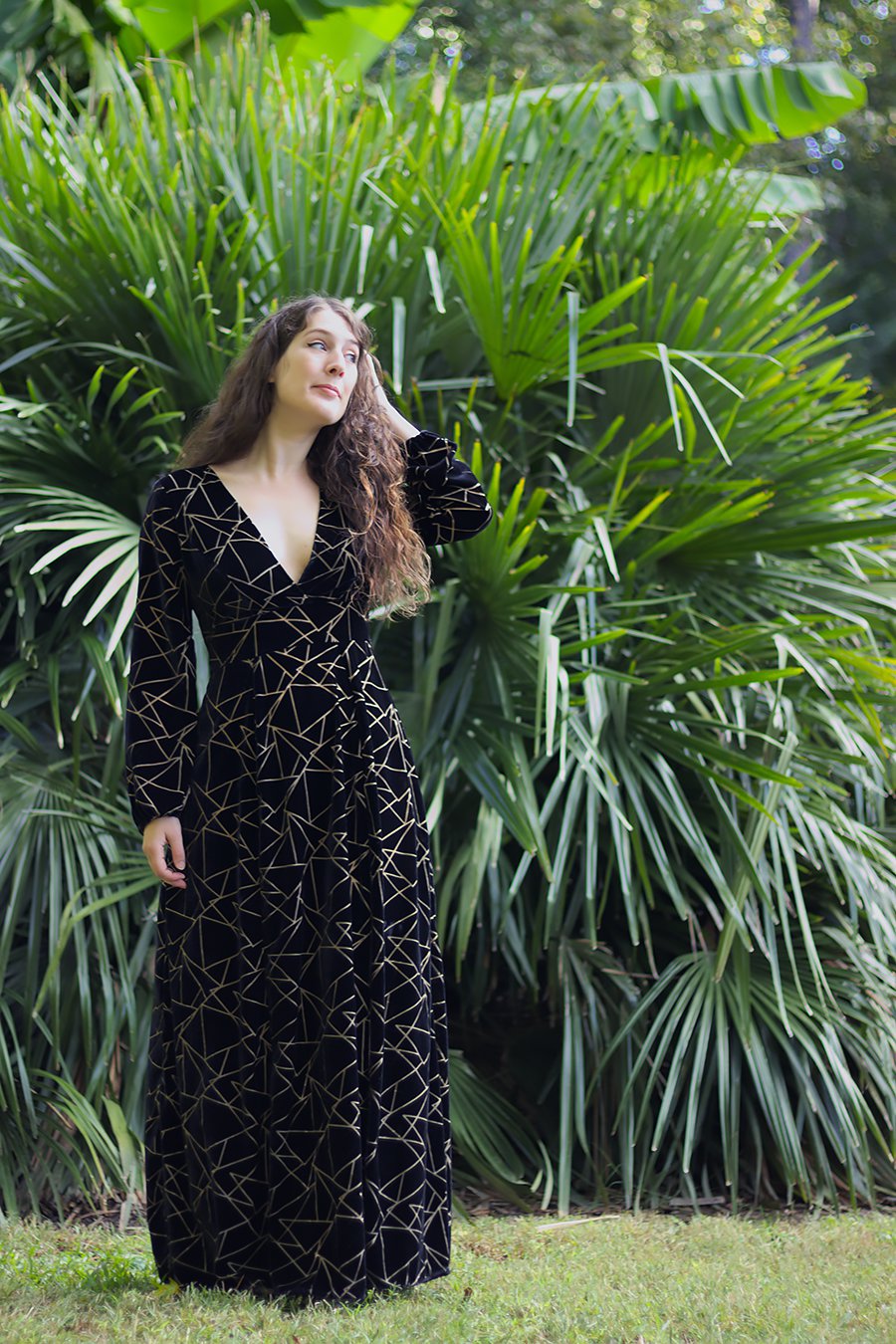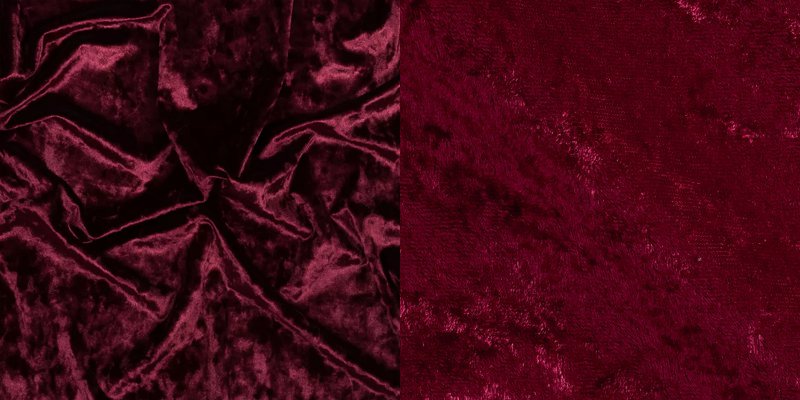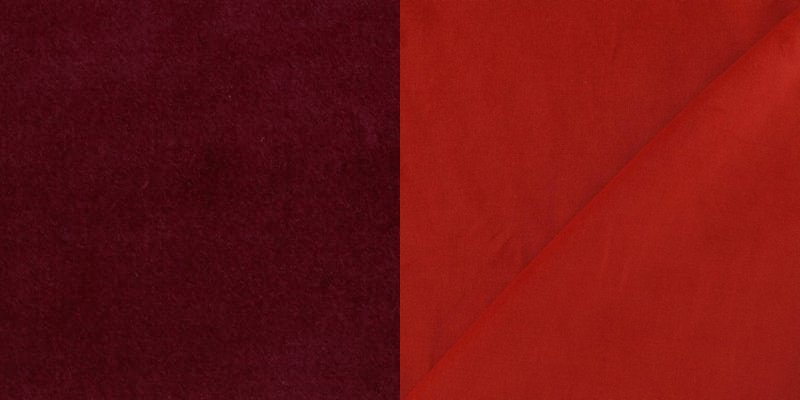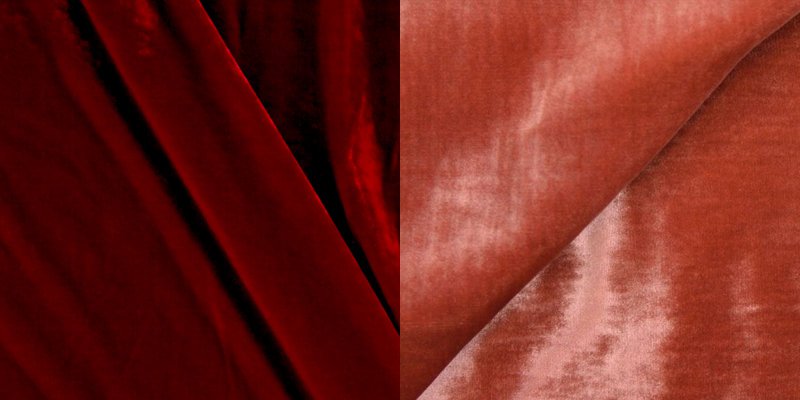There’s no escaping velvet this season! Did you know that there are many different types of velvet, some easier to handle than others? Whether you are a beginner or expert sewist, there is always one you can work with!
Contrary to what one might think, velvet is not linked to a specific fiber. It is actually the result of a weaving process, during which two layers are woven together, one on top of the other, and joined using a second warp thread. The pile is then cut to separate the two layers, and the threads that protrude vertically from the fabric create the texture that is typical of velvet.
The orientation of the pile threads changes the way the fabric reflects light, which is why you perceive the color of a velvet lighter or darker from different angles. It is thus particularly important to respect the nap by cutting all the pieces of a pattern in the same direction. Velvets cut with the nap going upwards reflect less light, which results in a deeper and more matte color, while velvets cut with the nap going downwards look shinier and marks on the fabric will be less obvious.
You can find velvet at all price-points, from the most expensive (woven from ultra-fine silk fibers) to the most affordable (cotton, rayon, polyester or acetate). You can also find them in many weights, from chiffon to the heaviest upholstery fabrics. Different treatments can also be done to velvet once the pile is cut, which will change its aspect and make it more or less easy to work with.
The most common types of velvet are the following, from the easiest to the most difficult:
- crushed and panne velvet
- velveteen
- corduroy
- embossed, brocade, and burnout velvet
- rayon and silk velvet
Crushed and panne velvet
What is it? Crushed velvet has a irregular moiré aspect. This is due to a fabrication process that twists the fabric and applies heavy pressure to flatten the pile so the nap is facing different directions. Panne velvet is a type of crushed velvet where the pile has been flattenned in the same direction all over. In the large majority of cases these velvets are stretchy, either because they contain elastane, or because their base is knitted and not woven. They are generally made out of polyester.
How to work with it? The pile of crushed velvet is already flat, so you can iron it from the wrong side and press seams open without leaving marks! A stretch crushed velvet is perfect for beginners, since the garment won’t need closures. Be careful with the direction of stretch though: a 2-way stretch panne velvet would work for a dress, but not for a bodysuit which would require a 4-way stretch crushed velvet that can stretch vertically as well.
Which patterns to choose? Choose a pattern for knits, preferrably not too close fitting since polyester is not breathable. A Zéphyr skirt or Plantain dress would be great choices.

Zéphyr skirt in stretch crushed velvet
Velveteen
What is it? This fabric has a short and dense pile, with a very uniform distribution, which makes it ressemble suede. Velveteen are usually 100% cotton, and have more body and less drape than regular velvet. Because of the shorter pile, they are also more matte.
How to work with it? Cotton is very heat-resistant and the very short pile of velveteen is less likely to be flattened, so you can prewash this fabric and even iron it from the wrong side. Avoid pressing seams directly with your iron however, since this could leave marks. Instead, apply a lot of steam and press the seam open with your fingers or with a wooden clapper.
Which patterns to choose? Velveteen is pretty stiff, so it is ideal for a pattern that needs some structure, such as the Belladone dress.

Rosari skirt (Pauline Alice) in velveteen
Corduroy
What is it? Corduroy is made with additional weft threads, woven and cut so as to form lines that run vertically along the fabric. It is a particularly sturdy fabric that is often 100% cotton but can also contain polyester or elastane. The ribs can be more or less wide, and are described by counting the number of ribs, or wales, per inch. Needlecords are the thinest at around 21 wales, while 14 wales corduroy is in the middle and 8 wales corduroy has wide ribs.
How to work with it? These fabrics can generally be machine-washed and ironed from the wrong side, by delicately lifting the iron and putting it down on the fabric instead of dragging it accross… but try it on a scrap of fabric first to be sure! In case ironing it flattens the ribs, you can still remove the wrinkles easily with a steamer. Be very careful to respect the grainline while cutting your pattern, since the vertical lines can make the slightest shift very obvious.
Which patterns to choose? Thanks to its sturdiness, corduroy is perfect for pants and shorts, such as Chataigne or Narcisse. Wide-rib corduroy can also be used to make jackets and coats, as you can see from the Opium coat made by l’Usine à Bulles and the Nénuphar jacket from Carina Spencer.
 Madeleine skirt (Victory Patterns) in needlecord
Madeleine skirt (Victory Patterns) in needlecord
Embossed, brocade, and burnout velvet
What is it? Embossed velvet has its pile crushed only in some places, which results in shine and color-depth differences which create a pattern on the fabric. The patterns on brocade velvet are woven with the extra warp thread, or by cutting the pile at different lengths. Finally, burnout velvet, also called velvet devore, is treated with acid that destroys part of the pile.
How to work with it? Don’t even think about ironing these fabrics: use steam only! You’ll also need to dry clean the final garment. Here it’s important to not only respect the direction of the nap, but also to match the patterns while cutting your pieces. With burnout velvet, you might also need to line some or all of your garment, since the parts that have been burned with acid are see-through.
Which patterns to choose? These are very luxurious fabrics, mostly used for evening wear: perfect for a Magnolia dress!

Magnolia dress in rayon burnout velvet
Rayon and silk velvet
What is it? Silk velvet is extremely fluid, and known to be one of the hardest fabrics to work with. These luxury fabrics are usually smooth, but one can also find embossed, brocade, or burnout silk velvets. Rayon velvet is similar to silk velvet in that it has a lot of drape, but it is less shiny and more affordable.
How to work with it? To tame these shifty fabrics, try basting at every step and sew by hand as much as possible, especially for hems (avoid topstitching). All previous advice still applies: no ironing, dry clean only, and use steam to open your seams!
Which patterns to choose? Choose a very simple pattern, to minimize seams and darts as much as possible, but also to let the fabric be the star. An Arum dress in silk velvet for instance would be perfect for the holidays.
Which types of velvet have you already sewn with, and which ones do you want to try? Do you have any tips to share for working with velvet?
3 commentaires
Carly, January 1 2019
I’ve been itching to try sewing with velvet and also have been wanting to try the Belladone dress. Do you think it could work with a cotton or rayon velvet? I saw you recommended it for use with velveteen, which is something I can try as well!
Camille, January 2 2019
It would work great in cotton velvet, but I would avoid rayon velvet as the Belladone is more on the structured side and needs a fabric that has body. Velveteen is in my opinion the best option 🙂








Alison, December 20 2018
Brilliant, thank you. I’ve been looking for info on how to pre treat velvet before making it up, this really helps.